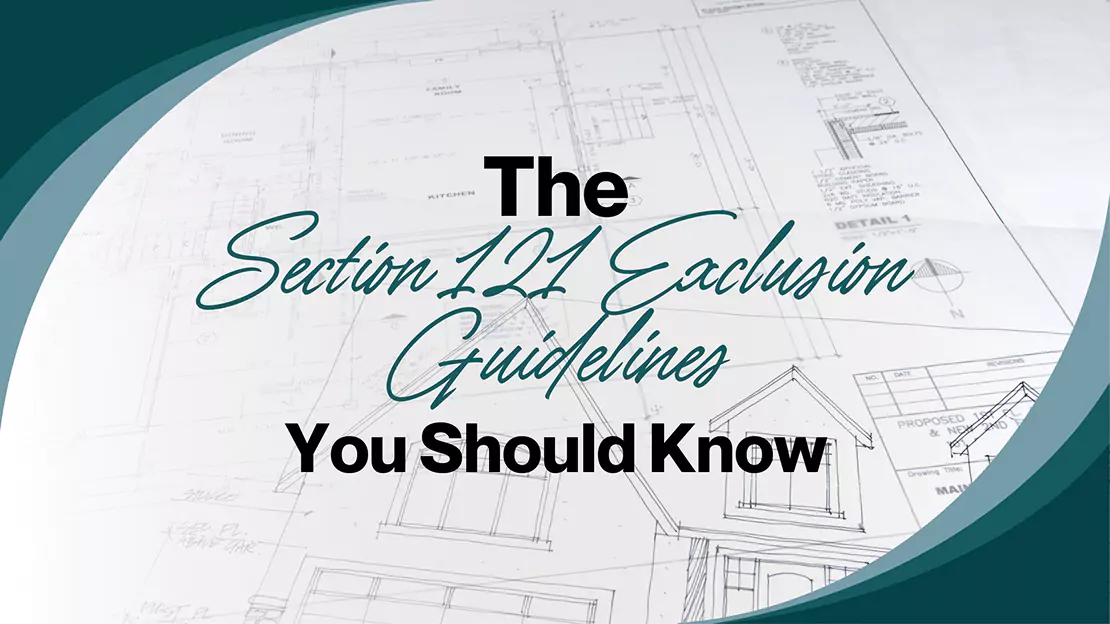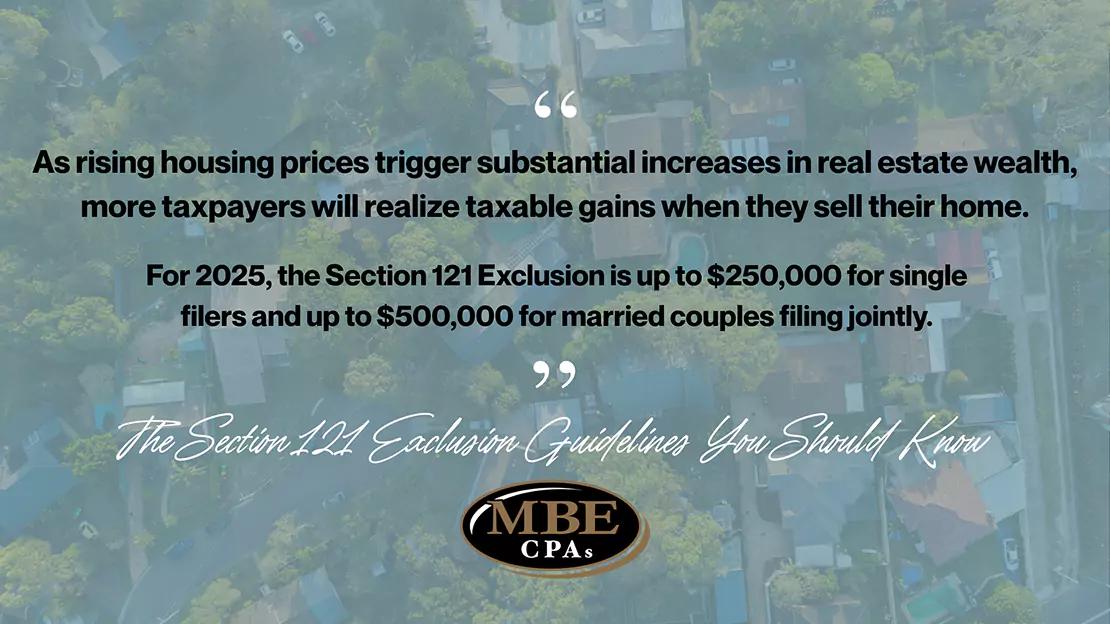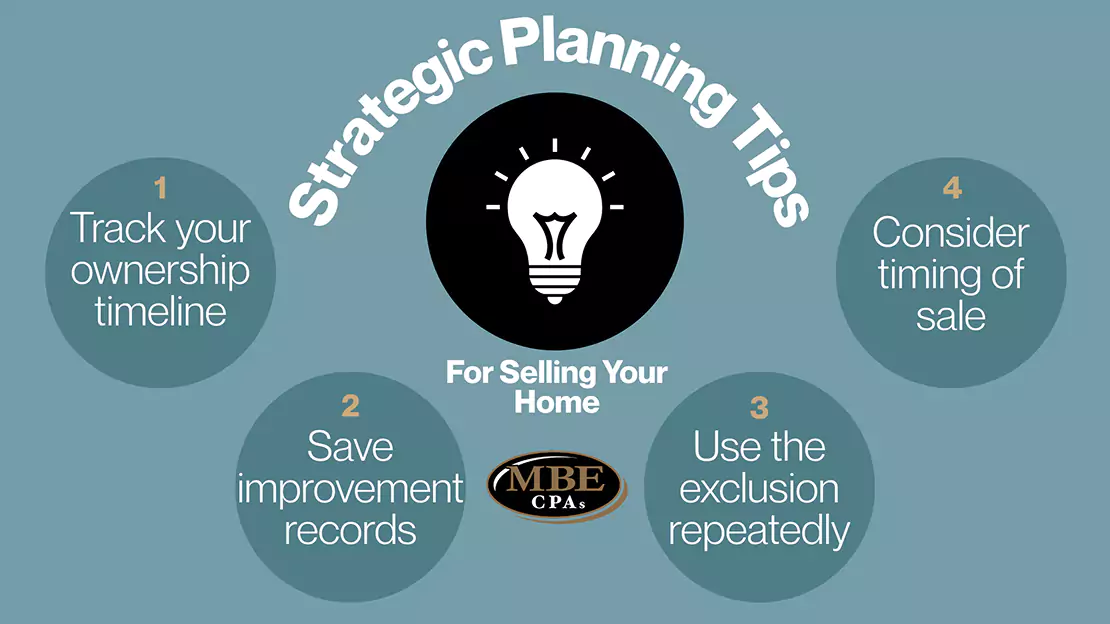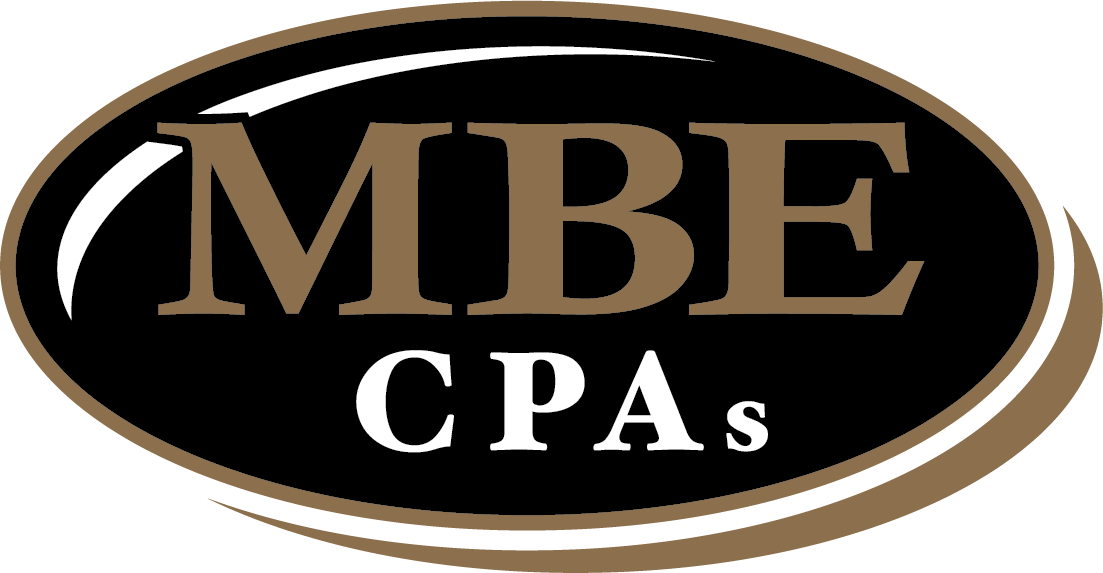The Section 121 Exclusion Guidelines You Should Know

Authored by: Brett Leibfried — Partner, CPA | Date Published: August 29, 2025
Selling your home can be one of life’s biggest financial transactions, and potentially one of the most tax-advantaged. What many homeowners don’t know is that you might not owe taxes on your profit. The Section 121 exclusion is a powerful tax benefit that allows homeowners to exclude capital gains from the sale of their primary residence.
Thinking of selling your home? Make sure you understand these rules first to help you potentially save thousands on taxes when you make the final sale.
Featured Topics:
What is the Section 121 Exclusion?
The Section 121 exclusion, established by the Internal Revenue Code, allows taxpayers to exclude significant capital gains from their gross income when selling their principal residence. If you meet the qualifying requirements, the profit you make from selling your home may be completely tax-free.
Here are the benefits of this exclusion at a glance:
- Single taxpayers can exclude up to $250,000 ($500,000 for certain joint returns) of tax-free gains.
- Married taxpayers filing jointly can exclude up to $500,000 if either spouse meets the ownership test, both spouses meet the use test, and neither spouse is ineligible due to a prior exclusion within the last two years.
- If both spouses do not meet the requirements for the $500,000 exclusion, each may claim up to $250,000 based on their individual eligibility.
- There is no limit on how many times you can use the exclusion (with timing restrictions).
The exclusion applies to your primary residence, not your investment properties. Taking advantage of this exclusion can help you save, which may benefit you in the future when considering retirement and other major life goals.
What are the Guidelines for the 121 Exclusion?
While the Section 121 exclusion offers significant opportunities for tax exclusions, taxpayers still must qualify. You must pass three tests that determine eligibility during the five-year period ending on your sale date. Read more about the requirements here.
- Ownership Test: You must have owned the home for at least two years (24 months or 730 days) out of the five years before the sale. For married couples filing jointly, only one spouse needs to meet the ownership requirement.
- Use (Residence) Test: You must have used the home as your principal residence for at least two years (24 months or 730 days) out of the five years before the sale. For married couples filing jointly, both spouses must meet the use requirement to qualify for the $500,000 exclusion.
- Look-Back Test: You cannot have excluded gain from the sale of another home during the two-year period ending on the date of the current sale.
It is important to note that the ownership and use periods don’t need to be continuous or overlap, giving you flexibility in your housing timeline.
Special Rules and Exceptions
Other than the three major tests, there are special rules and exceptions that have been established, including partial exclusions, surviving spouse cases, periods of unqualified use, etc.
- Partial Exclusion: If you do not meet the ownership and use requirements, you may still qualify for a partial exclusion. This applies if the sale was due to a change in place of employment, health reasons, or certain unforeseen circumstances (e.g., death, divorce, unemployment, etc.).
- The partial exclusion is calculated as a fraction of the maximum exclusion, based on the time you met the requirements.
- Surviving Spouse: A surviving spouse may claim up to $500,000 if the sale occurs within two years of the spouse’s death, the surviving spouse has not remarried, or the requirements for the $500,000 exclusion were met immediately before the spouse’s death.
- Business or Rental Use: If part of the property was used for business or rental and is separate from the dwelling unit, only the gain allocable to the residential portion is excludable. If the business or rental use was within the same dwelling unit, no allocation is required, but any depreciation claimed after May 6, 1997, must be recaptured and cannot be excluded.
Another special situation includes unqualified use periods. Gain from periods of unqualified use, when the property was not used as a principal residence, cannot be excluded, except for certain exceptions. This includes the time after the last use as a principal residence, up to ten years of qualified official extended duty, and up to two years of temporary absence for employment, health, or unforeseen circumstances.

121 Sale Exclusion Reporting Requirements
Keeping detailed records of your purchase price, improvements, and expenses will help you track your compliance with all requirements as well as calculating your capital gains. The question many sellers ask is whether you need to report the sale of your home to the IRS.
When you must report:
- Form 1099-S received: Always report the sale on Form 8949 and Schedule D.
- Taxable gain exists: Report any gain exceeding your exclusion limits.
- Mixed-use property: report when depreciation recapture applies.
However, if all gain is excluded, and you do not receive a Form 1099-S, you generally do not need to report the sale.
You are automatically disqualified for the exclusion if:
- The property was acquired in a like-kind exchange over the last 5 years.
- You are subject to expatriate tax.
To understand your obligations, check with an experienced professional. It’s important to consider any state or local taxes that can apply to the sale of your home, as well as any depreciation claimed. Setting up a consultation will help clarify your eligibility and navigate the complexities of tax laws.
Calculation of Gain and Basis Adjustments
Capital gains tax is the tax you pay on the net profit made from selling an asset. If you’ve owned your home for at least two years before selling, that’s when you have the chance to qualify for the residence exclusion of what you make from the sale.
The exclusion applies only to gains from your home’s sale, not losses. Gain is calculated as the amount realized (sale price minus selling expenses) minus the adjusted basis (original cost-plus improvements, minus certain adjustments such as depreciation).
To calculate capital gains tax on a home sale, you can follow these steps:
- Determine your basis: The price at which you bought your home plus any significant improvements (added value, prolonged useful life, or adaptations to new uses)
- Calculate your sale price: The amount you will sell your home for minus selling expenses.
- Find your gain: Subtract your basis from your sale price to find your gain, or possible loss.
- Adjust for the exclusion: If you qualify for the primary residence exclusion, you can reduce by up to $250,000-500,000 whether you’re a single filer or married and filing jointly.
Remember that capital gains tax can be affected by factors such as depreciation. Depreciation claimed for business or rental use after May 6, 1997, must be recaptured as unrecaptured section 1250 gain (the taxed gain from the sale of depreciated real property) and cannot be excluded.
The exclusion limits haven’t changed since 1997 despite the increase in home values, making your strategy for home sales even more important in today’s housing market. With many homes appreciating significantly, taking advantage of the home sale exclusion and learning what you qualify for can help you save thousands.
How MBE CPAs can Help
Tax laws surrounding home sales can be complex, especially with unique circumstances and mixed-use properties. Understanding what you qualify for when it comes to tax deductions and exclusions is not easy and MBE CPAs recognizes that.
Utilizing the guidance of an experienced professional will help you make sure that you are maximizing your finances when it comes to tax season.
Here are tips for strategic planning:
- Track Your Timeline: Document ownership and residence dates carefully.
- Save Improvement Records: Keep receipts for home improvements to increase your base.
- Plan Multiple Moves: Use the exclusion repeatedly, just not within two years of each other.
- Consider Timing: If you don’t meet the full requirements, evaluate if waiting longer might qualify you for more exclusion.
Along with retirement planning, college funds, and other major life goals, planning to sell your house must also consider timing and strategy. That’s why acquiring the help of an experienced advisor is your best move to make sure that you save what you qualify for.
A consultation with MBE CPAs can support you with the following actions:
- Determining your qualification status
- Calculating your potential tax savings
- Planning the optimal timing of sale
- Reporting the proper documentation
- Navigating state and local tax implications
Given the potential for tax savings, professional guidance often pays for itself many times over. Learn more about the services MBE CPAs provides here.

Conclusion
The Section 121 exclusion represents one of the most valuable tax benefits available to homeowners. By understanding the ownership requirements, you can potentially save thousands of dollars in capital gains taxes when selling your primary residence.
Given the complexity of certain sales situations, a qualified CPA will help you navigate your home sales and understand reporting requirements. Proper planning and documentation can ensure you maximize this valuable tax benefit while staying compliant with specific IRS regulations.
As housing values rise and tax laws become increasingly complex, consulting with an experienced advisor to correctly apply these guidelines is a valuable investment for optimizing your strategy.
